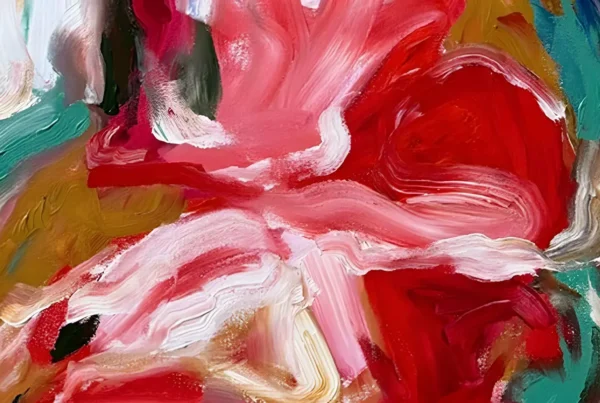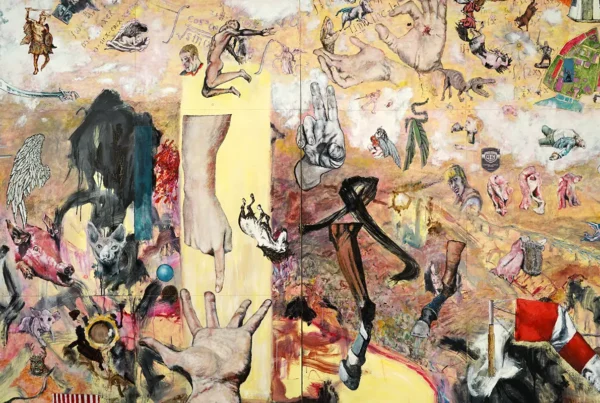“One dream that I have, is to be able to create art that can be experienced in other senses than through the eyes. Art to be felt, ‘not only’ to be seen.”
Vicki Svedrell: Rediscovering Art Through Adversity
Vicki Svedrell‘s journey into the world of art is a testament to resilience and the enduring spirit of creativity. Her childhood was marked by an early fascination with painting, a medium through which she expressed her burgeoning artistic sensibilities. This initial foray into the arts laid the groundwork for a lifelong passion. However, life had its twists and turns. As an adult, Svedrell faced a formidable challenge: a stroke that resulted in visual impairment. This unforeseen obstacle could have ended her artistic pursuits, but instead, it became a turning point. With determination and the support of fellow artists, she found innovative ways to overcome her limitations, allowing her to paint once again. These artists not only inspired her but also equipped her with practical solutions to navigate the difficulties posed by her visual impairment, thus reigniting her artistic flame.
Svedrell’s artistic evolution is deeply intertwined with her personal challenges, shaping her approach and perspective towards art. The stroke, while initially a setback, ultimately became a catalyst for a deeper exploration of her artistic capabilities. She was not only able to resume painting but also began to push the boundaries of her creativity. Embracing this second chance at her passion, Svedrell embarked on a journey of rediscovery, finding joy and freedom in the act of painting. This newfound perspective allowed her to explore uncharted territories of creativity, showcasing her resilience and adaptability as an artist. Her story is a powerful reminder of the capacity for human endurance and the transformative power of art in overcoming life’s unexpected hurdles.

A World in Watercolors: Exploring Inner Landscapes
Delving into the artistic style of Vicki Svedrell, one is immediately struck by her choice of medium: abstract watercolors. Each of her paintings is an adventure, a cautious journey into the depths of imagination and emotion. Svedrell’s approach is introspective and exploratory, as she navigates the complexities of the inner self. Her works are visual representations of internal landscapes, capturing the essence of moods, dreams, and sentiments. Through her art, she aims to tap into the subconscious, aspiring to evoke memories, dreams, or emotions in those who view her paintings. This intent to connect with the viewer on a deeper, more introspective level is a hallmark of her artistic philosophy.
In her studio, Svedrell creates these expressive pieces with a unique and minimalistic palette, primarily using indigo and quinacridone gold. This deliberate choice of colors is not just an aesthetic preference but a journey of discovery in itself. She explores the interaction and harmony between these colors, delving into their depths and nuances. The physical act of painting transports her into a world of her own, where she becomes completely immersed in her work, disconnected from external distractions. The tools of her trade are as unconventional as her style; she often employs chopsticks and various palette knives instead of traditional paintbrushes. This innovative approach not only signifies her adaptive skills in the face of visual impairment but also adds a distinctive texture and character to her paintings, making them uniquely Svedrell’s.

Vicki Svedrell: Inspirations That Shape the Canvas
Vicki Svedrell’s artistic journey is deeply influenced by a pantheon of legendary artists, each contributing to the tapestry of her creative vision. Frida Kahlo, known for her indomitable spirit and poignant self-portraits, stands as a beacon of inspiration for Svedrell. Kahlo’s ability to transcend her physical constraints and to paint her own reality resonates deeply with her, echoing her own experiences with overcoming adversity. Similarly, Wassily Kandinsky’s work, especially his use of color and his relentless exploration of the new, has left an indelible mark on Svedrell’s approach to art. Kandinsky’s “Composition VI” holds a special place in her heart, embodying a blend of despair and hope, a thematic duality that Svedrell finds particularly compelling.
Svedrell’s artistic influences extend beyond the emotional resonance of Kahlo and Kandinsky. Henri Matisse’s pursuit to “paint the sign of the tree” mirrors her own quest to capture the essence of her subjects. Matisse’s attitude towards his motifs, seeking to represent their underlying truth rather than their mere appearance, is a concept that Svedrell strives to emulate in her work. Similarly, Pablo Picasso’s philosophy of painting with the uninhibited perspective of a child aligns with her approach to art. Picasso’s advocacy for keeping an open mind and viewing the world with fresh eyes inspires Svedrell to approach her paintings without preconceived notions, allowing for boundless creativity. These artistic giants, with their distinct styles and philosophies, collectively shape Svedrell’s artistic identity, guiding her in her continuous exploration of the abstract and the emotive.

Beyond Sight: Art for All Senses
At the heart of Vicki Svedrell’s artistic aspirations lies a dream to transcend traditional visual art forms. She envisions creating art that is accessible not just visually, but through other senses as well. Svedrell’s commitment to inclusivity reflects her desire to reach audiences beyond those who can see, particularly the visually impaired and blind. She is drawn to the concept of tactile art – art that can be experienced through touch. This ambition is not just a creative pursuit but a deeply personal one, stemming from her own experiences with visual impairment. She aims to use techniques like swelling pictures, which allow patterns and motifs to be felt, providing a sensory experience that can evoke the same depth of emotion and interpretation as visual art.
Svedrell’s dedication to this inclusive approach is emblematic of her broader philosophy towards art. For her, art is not a static, one-dimensional form of expression but a dynamic, multi-sensory experience. She seeks to break down the barriers that limit art’s accessibility, championing the idea that art should be an inclusive realm where every individual, regardless of their sensory abilities, can experience and interpret creativity in their own way. This pursuit of tactile art is not just a technical challenge but a mission to redefine the boundaries of artistic expression. By integrating texture and physicality into her work, Svedrell aims to create a bridge between the visual and tactile worlds, offering a novel way for people to connect with art and, by extension, with each other. Her vision is a testament to the power of art to unite, inspire, and transform, transcending traditional modes of perception and communication.






